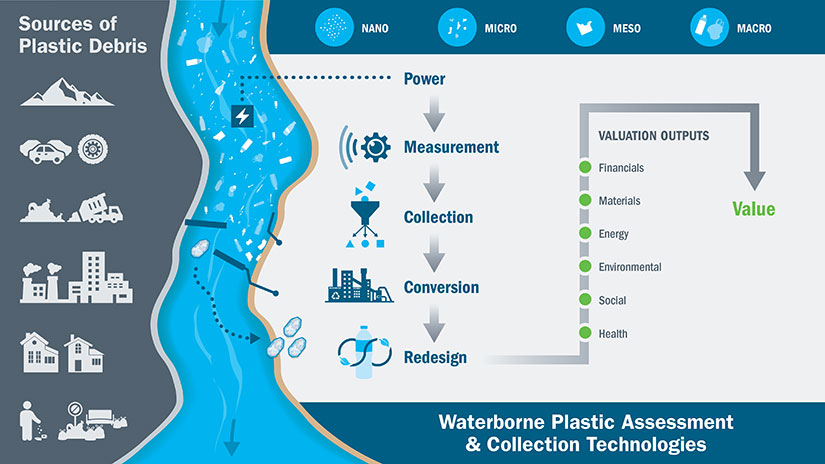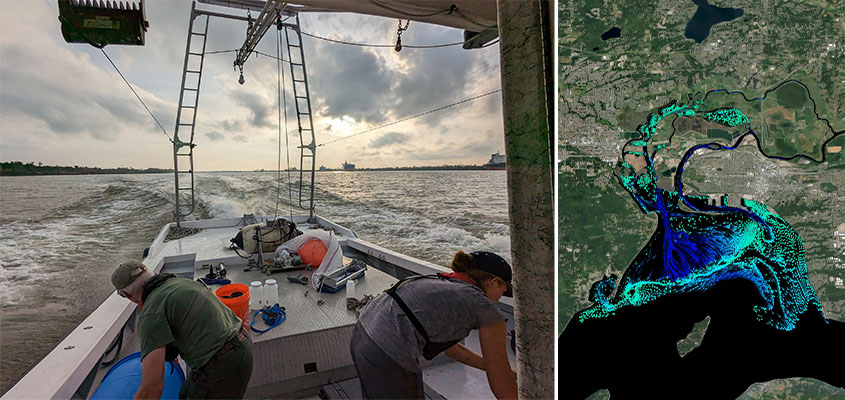Waterborne Plastics Assessment and Collection Technologies
With support from the U.S. Department of Energy (DOE), NLR has collected data on waterborne plastics debris as part of the Waterborne Plastics Assessment and Collection Technologies (WaterPACT) project.
Plastics are a marvel of modern industry and a critical material throughout the energy sector. Polymers, which are derived largely through fossil fuel refinement, reliably and cost-effectively shield nuclear reactors, store chemical fuels, stiffen wind turbine blades, encase photovoltaic cells, electrically insulate power lines, thermally insulate buildings, purify industrial water streams, lighten vehicles and aircraft, separate battery electrolytes, provide structure to circuit boards, strengthen tires, and more. U.S. energy companies support approximately 59 million metric tons of plastics production a year.
No waste management system is perfect, and a small percentage of those plastics escape into America’s natural resources, eventually concentrating in our rivers. As plastics waste production increases, American innovation is needed to develop sensors and collectors to address the growing concern of plastics pollution. There is a clear opportunity for energy technologies to power the measurement and removal of plastics and potentially reintroduce them into plastics supply chains.

Plastic debris across a range of sizes, colors, shapes, and chemistries arrive in U.S. waterways from a variety of industrial, commercial, transportation, and residential sources. This project aims to develop pathways to recover that pollution as a resource. Graphic by Elizabeth Stone, National Laboratory of the Rockies
NLR is well positioned to study waterborne plastics pollution for several reasons:
- Sources of waterborne plastics debris are across all energy sectors, including industry, commerce, transportation, and residential.
- Reclaiming plastic debris also reclaims the money, energy, and materials initially invested in the production of plastic materials.
- Researchers at DOE's national laboratories have the expertise, experience, and existing technological capabilities at hand to address this problem.
Advances in energy research, including hydrokinetic or solar supported by DOE, could power in-water technology solutions for waterborne plastics. A federal effort is well suited to help state and local governments and nongovernmental organizations address a challenge of this scale. For these reasons, DOE launched WaterPACT in 2020, in which project partners work to characterize and remove waterborne plastics debris in the United States.
With support from DOE, NLR and Pacific Northwest National Laboratory are in the late stages of completing a nationwide field measurement campaign and conducting predictions to amass accessible, actionable, and consistent data on waterborne plastics debris. The national labs will build on this information to foster technology development in plastics debris measurement, collection, conversion (recycling or upcycling), and product redesign.
Vision and Mission
The WaterPACT project’s long-term vision is to deliver a suite of energy-powered technologies to sense, collect, and convert waterborne plastics and redesign the plastics life cycle to avoid contaminating waterways.
The project team will:
- Create a national-scale, broad-spectrum characterization of U.S. waterborne plastics properties, trends, values, and social contexts in partnership with partner agencies
- Develop a set of integrated modeling tools to predict pathways of plastics in U.S. waterways and coastal seas and assess the impacts of plastic pollution in marine environment and human health
- Develop targeted technologies to reclaim and remediate waterborne plastics pollution in partnership with other energy innovators and the myriad organizations operating in this space.
To achieve this vision, the WaterPACT team will pursue four mission aims:
- Characterize, quantify, model, and estimate the value of the range of U.S. waterborne plastics and leachates (chemicals from plastics that leach into water)
- Develop models, analyses, and technologies to reclaim and remediate waterborne plastics debris
- Leverage funding from DOE in distributed energy generation, blue economy markets, materials characterization, recycling/upcycling, modeling, and data science to support technology developers
- Identify, understand, and reduce plastics-pollution-related environmental and health stressors impacting Americans.
Timeline
Phase 1 (Fiscal Years 2022–2025): Assessment
Phase 1 includes gathering foundational field and laboratory measurements, modeling the flow of plastics, estimating the value of their recovery, and sharing data broadly.

WaterPACT researchers from Louisiana State University collect field samples from the Mississippi River Basin (left). The basin is downstream of a major urban center and upstream of the river mouth to the Gulf. A satellite image of the Delaware Watershed (right) is overlain with computational model results of plastic particulates carried downstream to the Delaware Bay. Photo on left by Ben Maurer, National Laboratory of the Rockies; image on right from Taiping Wang, Pacific Northwest National Laboratory
Phase 2 (Fiscal Years 2026–2028): Collection
Phase 2 is organized into a portfolio of two R&D pillars—sensing and collection—with an emphasis on returning quantified values to recycled polymer supply chains and avoiding costs to Americans.
Phase 3 (Fiscal Year 2029 and Beyond): Industry-Led Research and Development
Phase 3 involves the transfer of portfolio funding and management to a consortium of stakeholders across plastics production, consumer goods, interested state and local governments, nongovernmental organizations, energy technology developers, and sensing, collection, conversion, and redesign technology developers.
Measuring Success
The WaterPACT team aims to achieve the following long-term goals:
- Achieve readily deployable, cost-effective technology solutions for sensing and collecting plastics pollution in U.S. waterways
- Remove over 50% of suspended and floating waterborne plastics debris in U.S. waterways by 2040
- Provide industry with key self-monitoring and remediation tools to address upstream and downstream plastics pollution.
Scope and Partners
Experts at NLR are leading the WaterPACT project in collaboration with researchers at the Pacific Northwest National Laboratory and the Environmental Molecular Sciences Laboratory.
Critical Phase 1 project partners include U.S. Environmental Protection Agency Region 3, Louisiana State University, University of California Riverside, Oregon State University, Portland State University, and the Moore Institute.
Publications
Modeling the Microplastic Distribution Along the Delaware River Estuary: Accumulation Patterns and Hydrodynamic Influences, Marine Pollution Bulletin (2025)
Generation of Macro- and Microplastic Databases by High-Throughput FTIR Analysis With Microplate Readers, Analytical and Bioanalytical Chemistry (2024)
Quantifying the Influence of Size, Shape, and Density of Microplastics on Their Transport Modes: A Modeling Approach, Marine Pollution Bulletin (2024)
Riverine Plastic Pollution: Field Sampling Protocol and Implementation in U.S. Rivers, Pacific Northwest National Laboratory Technical Report (2023)
Riverine Plastic Pollution: Sampling and Analysis Methods, Pacific Northwest National Laboratory Technical Report (2022)
Contact
Share
Last Updated Dec. 6, 2025
